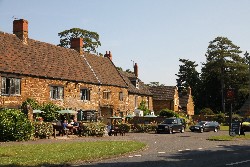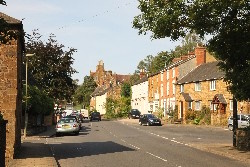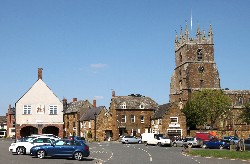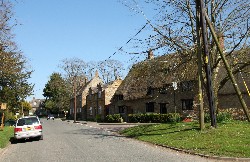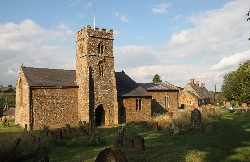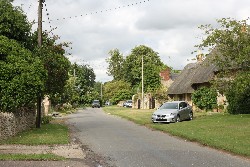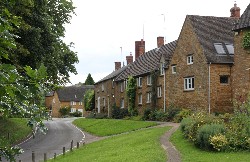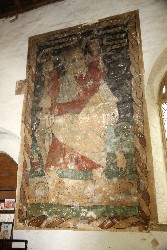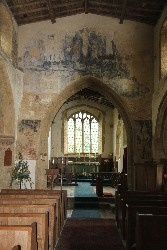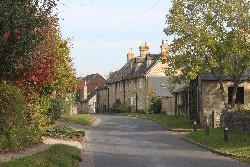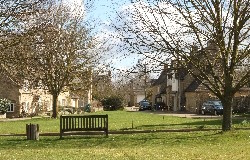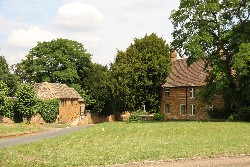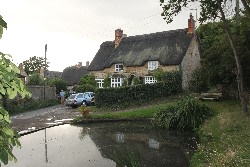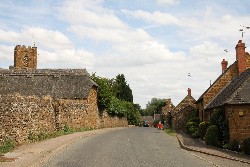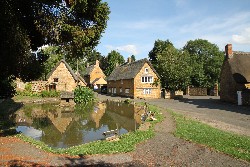


























RECOMMENDED VILLAGES TO VISIT IN CHERWELL
|
|
Adderbury is about 3 miles south of Banbury on the A4260 Oxford to Banbury road. |
2 Bloxham
Church Street is dominated by the impressive looking church, the Church of St. Mary, Our Lady of Bloxham. Its 14th century tower and spire is a local landmark and said to be the highest in Oxfordshire. In the centre of the village are the equally impressive looking buildings of Bloxham School, a co-educational boarding and day school for children 11 - 18 years old. Bloxham is about 3 miles south-west of Banbury on the A361 Banbury to Chipping Norton road. |
| 3 Deddington
Just to the east of the village is the site of Deddington Castle. This was a motte and bailey castle but all that remains of it now are the striking earthworks which are a public recreation area. Deddington is about 6 miles south of Banbury on the A4260 Oxford to Banbury road.
|
4 Duns Tew
The unusual name of the village is believed to have been derived from the Anglo-Saxon name 'Dunn'. 'Tew' is thought to mean 'ridge' and this part of the name is shared by two other nearby villages, namely Great and Little Tew. Duns Tew is about 7 and a half miles south of Banbury, just off the A4260 Oxford to Banbury road.
|
5 Epwell
The little village church, St. Anne's, is on a mound, giving it a prominent position in the village, and you can almost imagine sheep grazing in the peaceful grassy churchyard. The building is Early English and several of the windows are Decorated Gothic. The bell tower is Perpendicular Gothic. Epwell is about 6 miles west of Banbury close to the county border with Warwickshire. |
|
There are several pretty thatched cottages in the village, and the village pump in Main Street has a pretty thatched roof. The novelist Flora Thompson spent her childhood and early life in Fringford and the nearby hamlets of Juniper Hill and Cottisford which are a little to the north of Fringford. In her trilogy Lark Rise to Candleford she recalls her childhood in Juniper Hill (Lark Rise) and at school in Cottisford (Fordlow) before moving to Fringford (Candleford Green) where she worked in the village post office from 1891 to 1897. Her fictitious town of Candleford is thought to be a combination of the nearby towns Banbury, Bicester and Buckingham. Fringford is about 4 miles north-east of Bicester. |
7 Hanwell
Next to the church is Hanwell Castle, never actually a castle but a large house with ornamental battlements which was originally called Hanwell House or Hall. Most of the building was demolished late in the 18th century but the western part of the south range was retained as a farmhouse. In 1902 some restoration and extensions were made to the surviving building. Hanwell is about 2 miles north-west of Banbury |
|
The village is well known as the home of Hook Norton Brewery. The brewing plant is a traditional Victorian "tower" brewery. Until 2006, the brewing process was powered by steam and the brewery still maintains the tradition of delivering beer in the village by horse drawn dray. The brewery has a visitor centre and is open to the public. The parish church, St. Peter's, is in the centre of the village. The church is of Norman origin but also has some Early English, Decorated Gothic and Perpendicular Gothic features. Like in several other nearby churches, St. Peter's has a number of medieval wall paintings, including paintings of saints, angels and the Apostles St. Peter and St. Paul. Hook Norton is about 4.5 miles north-east of Chipping Norton, about 2 miles to the north of the A361 Banbury to Chipping Norton road. |
9 Horley
The village is worth seeing, but the real attraction is the beautiful parish church of St. Etheldreda, which dates from the 12th century and has several medieval wall paintings, most of which were uncovered in the mid-19th century. The most important of the wall paintings is a large paiting of St. Christopher. On one of the pillars there is a painting of St. Zita and there are other paintings elswhere which are now fragmentary. The painted rood, rood screen and loft date from the mid-20th century as are the decorations to the pulpit, which depicts scenes from the life of St. Etheldreda. Horley is about 3 miles north-west of Banbury, west of the B4100 |
10 Hornton
In the centre of the village is a small triangular green with pretty thatched cottages on two sides. Near the green is the manor house, built in the early 17th century. The parish church, the Church of St. John the Baptist, dates from the 12th century and has some 14th century wall paintings including a painting Doom painting over the chancel arch, a Pietà and a painting of St. George. Nearby is Edgehill where the first battle of the Civil War was fought in October 1642. Hornton is about 3 miles north-west of Banbury. |
11 Islip
Islip is proud to have been the birthplace of Edward the Confessor in around 1005. In 2005, 1,000 years after Edward's birth, the village was visited by the Time Team TV programme which carried out a search for a possible Saxon royal palace. Another TV programme which included parts of Islip was an episode of Midsomer Murders, in which Islip bridge and The Swan Inn were featured. Islip is about 2 miles east of Kidlington on the B4027 between Bletchingdon and Beckley. |
12 Kirtlington
About a quarter of a mile away to the west are the Oxford Canal and the River Cherwell, which run side-by-side. Nearby Kirtlington Park is a Grade 1 listed 18th century country house set in historic parklands with far-reaching views over the Chiltern Hills, and it is a popular venue for weddings. The Kirtlington Park Polo Club is based at Kirtlington Park and it holds weekly matches during the summer season. Kirtlington is about six and a half miles west of Bicester and about 4 miles north of Kidlington on the A4095. |
13 Shenington
Shenington is the larger, and more attractive of the two villages. In the centre is an attractive village green with golden-brown cottages around its edge, and close to the green is the village church, Holy Trinity, which dates from the 12th and 13th century. Shenington is about 5 miles north-west of Banbury. |
|
The unusually shaped Manor House in Sibford Gower was built in the 17th century and substantially remodelled between 1907 and 1915 by Frank Lascelles, a pageant master, artist and sculptor, and a blue plaque has been erected in commemoration at the entrance to the house. Sibford Gower became associated with clock-making in the seventeenth century when Quaker Thomas Gilkes, a local man, became a clockmaker. Gilkes pioneered a clockmaking industry in north Oxfordshire villages with such success that Quakers, including several further members of the Gilkes and Fardon families, dominated the trade in parts of the district for the next 150 years. Sibford Gower is about 6.5 miles west of Banbury, close to the county border with Warwickshire. |
15 Swalcliffe
In the centre of the village is a small triangular green, opposite the parish church. Near the church is Swalcliffe Barn which has an almost completely intact medieval timber half-cruck roof and is considered the finest medieval tithe barn in Oxfordshire and one of the best examples in England, with much of its medieval timber roof intact. The barn houses part of the Oxfordshire Museum's collection of traditional agricultural and trade vehicles. North of the village are the site of an Iron Age hill fort and the site of a Roman villa which is near course of a former Roman Road. It has been suggested that there was a Roman or Romano-British village here. Swalcliffe is about 5 miles west of Banbury on the B4035. |
16 Wardington
The main road through Lower Wardington winds up the side of a hill, and the dark ironstone cottages continue along the lane to Upper Wardington. Upper Wardington is at the top of the hill and here there are several more attractive honey-coloured cottages, many of them overlooking pleasant greens. Wardington is about 4 miles north-east of Banbury, very close to the county boundary with Northamptonshire. |
17 Wroxton
To the south of the village is Wroxton College which is housed in the buildings and grounds of Wroxton Abbey. The building is a modernised 17th century Jacobean manor house which was built on the foundations of a 13th century Augustinian priory. Wroxton College is an overseas campus of the American Fairleigh Dickinson University. In the Abbey grounds (which are normally open to the public) there is a dovecote in the style of a Gothic octagonal tower with battlements, sometimes referred to as the Wroxton Castle. As well as the dovecote thereare two other follies - an obelisk and a folly in the form of two 40ft towers with an arch between. On the western edge of the village, on the North Newington Road, is a 17th century guide post which gives directions (with carved hands) to Banbury, Chiping Norton (sic), London, and Stratford, and with various forms of sundial on each of the four sides. Wroxton is about 3 miles west of Banbury on the A422 Banbury to Stratford-upon-Avon road. |

